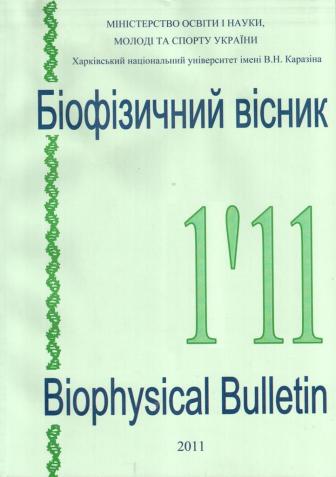Mechanism of activation by ca2+ of hemolysis induced by lytic polypeptide equinatoxin ii
Abstract
Equinatoxin II is a cytolytic polypeptide from the sea anemone Actinia equina L. which forms pores in
natural and artificial membranes. In the present study, we show that the mechanism by which Ca2+
activates toxin-induced hemolysis of human red blood cells consists of the ability of Ca2+ which enters
the cell presumably through preformed toxin-induced pores and acts inside the cell to increase the rate of
toxin binding to the membrane. As a result, a larger amount of pores is produced thus increasing the rate
of hemolysis. In addition, the data reveal that equinatoxin II induces hemolysis of RBC interacting with a
limited number of toxin-binding sites (receptors) with an upper estimate of (180 35) 103 sites per one
cell. The total number of toxin-binding sites does not depend on the presence of Ca2+. These data strongly
suggest that specific receptor must exist on the erythrocyte membrane to mediate the hemolytic action of
this toxin.
Downloads
References
2. Belmonte G, Pederzolli C, Macek P, Menestrina G. Pore formation by the sea anemone cytolysin equinatoxin II in red blood cells and model lipid membranes. J.Membr.Biol. 1993;131(1):11-22.
3. Bunc M, Drevensek G, Budihna M, Suput D. Effects of equinatoxin II from Actinia equina (L.) on isolated rat heart: the role of direct cardiotoxic effects in equinatoxin II lethality. Toxicon 1999;37(1):109-23.
4. Frangez R, Meunier F, Molgo J, Suput D. Equinatoxin II increases intracellular Ca2+ in NG 108-15 cells. Pflugers Arch. 2000;439(3 Suppl):R100-R101.
5. Hewlett EL, Gray L, Allietta M, Ehrmann I, Gordon VM, Gray MC. Adenylate cyclase toxin from Bordetella pertussis. Conformational change associated with toxin activity. J.Biol.Chem. 1991;266(26):17503-8.
6. Hoffman JF. On the mechanism and measurement of shape transformations of constant volume of human red blood cells. Blood Cells 1987;12(3):565-88.
7. Lafranconi WM, Ferlan I, Russell FE, Huxtable RJ. The action of equinatoxin, a peptide from the venom of the sea anemone, Actinia equina, on the isolated lung. Toxicon 1984;22(3):347-52.
8. Macek P, Belmonte G, Pederzolli C, Menestrina G. Mechanism of action of equinatoxin II, a cytolysin from the sea anemone Actinia equina L. belonging to the family of actinoporins. Toxicology 1994;87(1-3):205-27.
9. Macek P, Lebez D. Kinetics of hemolysis induced by equinatoxin, a cytolytic toxin from the sea anemone Actinia equina. Effect of some ions and pH. Toxicon 1981;19(2):233-40.
10. Mally M, Majhenc J, Svetina S, Zeks B. Mechanisms of equinatoxin II-induced transport through the membrane of a giant phospholipid vesicle. Biophys.J. 2002;83(2):944-53.
11. Menestrina G, Schiavo G, Montecucco C. Molecular mechanisms of action of bacterial protein toxins. Mol.Aspects.Med. 1994;15(2):79-193.
12. Pasternak CA, Alder GM, Bashford CL, Buckley CD, Micklem KJ, Patel K. Cell damage by viruses, toxins and complement: common features of pore-formation and its inhibition by Ca2+. Biochem.Soc.Symp. 1985a;50:247-64.
13. Pasternak CA, Alder GM, Bashford CL, Buckley CD, Micklem KJ, Patel K. Cell damage by viruses, toxins and complement: common features of pore-formation and its inhibition by Ca2+. Biochem.Soc.Symp. 1985b;50:247-64.
14. Portlock SH, Clague MJ, Cherry RJ. Leakage of internal markers from erythrocytes and lipid vesicles induced by melittin, gramicidin S and alamethicin: a comparative study. Biochim.Biophys.Acta 1990;1030(1):1-10.
15. Rudenko SV, Nipot EE. Protection by chlorpromazine, albumin and bivalent cations against haemolysis induced by melittin, [Ala-14]melittin and whole bee venom. Biochem.J. 1996;317 ( Pt 3):747-54.
16. Teng CM, Lee LG, Lee CY, Ferlan I. Platelet aggregation induced by equinatoxin. Thromb.Res. 1988;52(5):401-11.
17. Zorec R, Tester M, Macek P, Mason WT. Cytotoxicity of equinatoxin II from the sea anemone Actinia equina involves ion channel formation and an increase in intracellular calcium activity. J.Membr.Biol. 1990;118(3):243-9.
Authors who publish with this journal agree to the following terms:
- Authors retain copyright and grant the journal right of first publication with the work simultaneously licensed under a Creative Commons Attribution License that allows others to share the work with an acknowledgement of the work's authorship and initial publication in this journal.
- Authors are able to enter into separate, additional contractual arrangements for the non-exclusive distribution of the journal's published version of the work (e.g., post it to an institutional repository or publish it in a book), with an acknowledgement of its initial publication in this journal.
- Authors are permitted and encouraged to post their work online (e.g., in institutional repositories or on their website) prior to and during the submission process, as it can lead to productive exchanges, as well as earlier and greater citation of published work (See The Effect of Open Access).





